The Intel Haswell-E CPU Review: Core i7-5960X, i7-5930K and i7-5820K Tested
by Ian Cutress on August 29, 2014 12:00 PM ESTEvolution in Performance
The underlying architecture in Haswell-E is not anything new. Haswell desktop processors were first released in July 2013 to replace Ivy Bridge, and at the time we stated an expected 3-17% increase, especially in floating point heavy benchmarks. Users moving from Sandy Bridge should expect a ~20% increase all around, with Nehalem users in the 40% range. Due to the extreme systems only needing more cores, we could assume that the suggested recommendations for Haswell-E over IVB-E and the others were similar but we tested afresh for this review in order to test those assumptions.
For our test, we took our previous CPU review samples from as far back as Nehalem. This means the i7-990X, i7-3960X, i7-4960X and the Haswell-E i7-5960X.
Each of the processors were set to 3.2 GHz on all the cores, and set to four cores without HyperThreading enabled.
Memory was set to the CPU supported frequency at JEDEC settings, meaning that if there should Intel have significantly adjusted the performance between the memory controllers of these platforms, this would show as well. For detailed explanations of these tests, refer to our main results section in this review.
Average results show an average 17% jump from Nehalem to SNB-E, 7% for SNB-E to IVB-E, and a final 6% from IVB-E to Haswell-E. This makes for a 31% (rounded) overall stretch in three generations.
Web benchmarks have to struggle with the domain and HTML 5 offers some way to help use as many cores in the system as possible. The biggest jump was in SunSpider, although overall there is a 34% jump from Nehalem to Haswell-E here. This is split by 14% Nehalem to SNB-E, 6% SNB-E to IVB-E and 12% from IVB-E to Haswell-E.
Purchasing managers often look to the PCMark and SYSmark data to clarify decisions and the important number here is that Haswell-E took a 7% average jump in scores over Ivy Bridge-E. This translates to a 24% jump since Nehalem.
Some of the more common synthetic benchmarks in multithreaded mode showed an average 8% jump from Ivy Bridge-E, with a 29% jump overall. Nehalem to Sandy Bridge-E was a bigger single jump, giving 14% average.
In the single threaded tests, a smaller overall 23% improvement was seen from the i7-990X, with 6% in this final generation.
The take home message, if there was one, from these results is that:
Haswell-E has an 8% improvement in performance over Ivy Bridge-E clock for clock for pure CPU based workloads.
This also means an overall 13% jump from Sandy Bridge-E to Haswell-E.
From Nehalem, we have a total 28% raise in clock-for-clock performance.
Looking at gaming workloads, the difference shrinks. Unfortunately our Nehalem system decided to stop working while taking this data, but we can still see some generational improvements. First up, a GTX 770 at 1080p Max settings:
The only title that gets much improvement is F1 2013 which uses the EGO engine and is most amenable to better hardware under the hood. The rise in minimum frame rates is quite impressive.
For SLI performance:
All of our titles except Tomb Raider get at least a small improvement in our clock-for-clock testing with this time Bioshock also getting in on the action in both average and minimum frame rates.
If we were to go on clock-for-clock testing alone, these numbers do not particularly show a benefit from upgrading from a Sandy Bridge system, except in F1 2013. However our numbers later in the review for stock and overclocked speeds might change that.
Memory Latency and CPU Architecture
Haswell is a tock, meaning the second crack at 22nm. Anand went for a deep dive into the details previously, but in brief Haswell bought better branch prediction, two new execution ports and increased buffers to feed an increased parallel set of execution resources. Haswell adds support for AVX2 which includes an FMA operation to increase floating point performance. As a result, Intel doubled the L1 cache bandwidth. While TSX was part of the instruction set as well, this has since been disabled due to a fundamental silicon flaw and will not be fixed in this generation.
The increase in L3 cache sizes for the highest CPU comes from an increased core count, extending the lower latency portion of the L3 to larger data accesses. The move to DDR4 2133 C15 would seem to have latency benefits over previous DDR3-1866 and DDR3-1600 implementations as well.


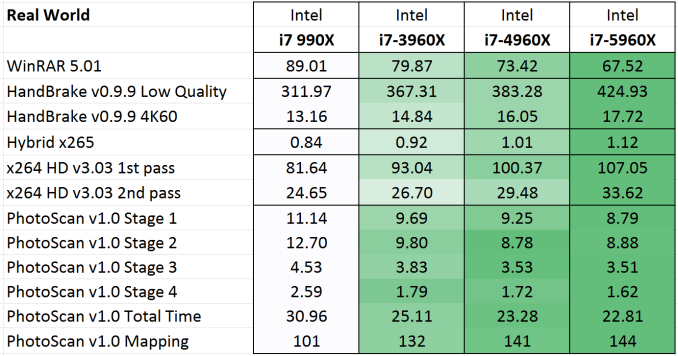


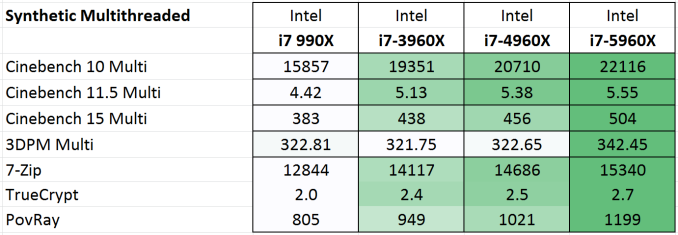

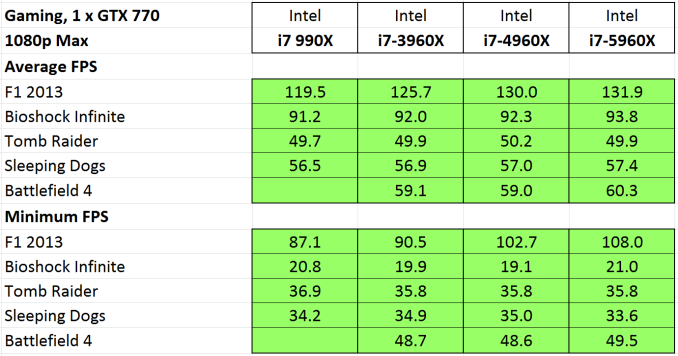
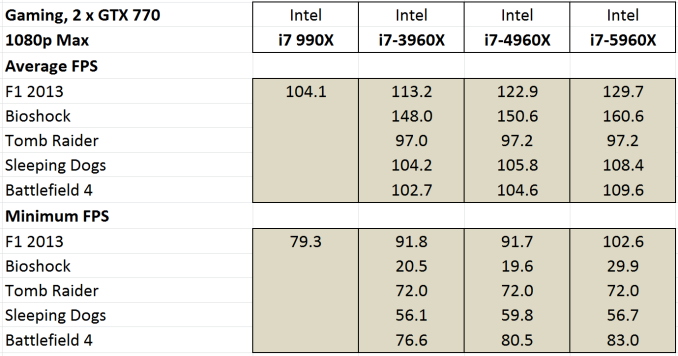
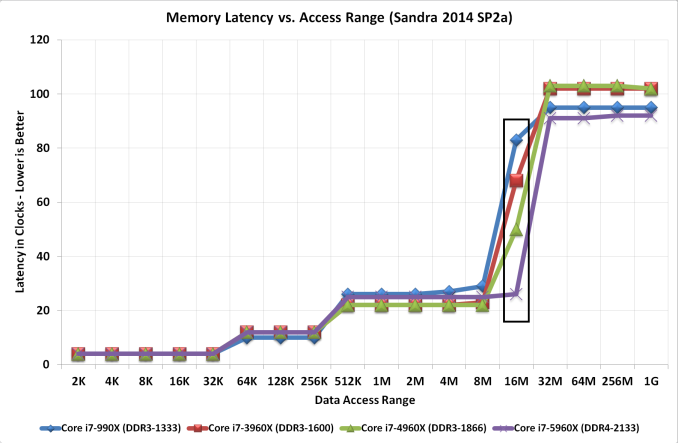








203 Comments
View All Comments
TiGr1982 - Tuesday, September 2, 2014 - link
Right. Gulftown was the 32 nm shrink of 45 nm Nehalem. However, in that case there was no associated IPC change (except AES addition in Gulftown), so in light-threaded tasks there was no performance difference between the two (except AES), so people often informally confuse the two, despite the fact that Gulftown has two more cores due to the 32 nm instead of 45 nm.SantaAna12 - Friday, August 29, 2014 - link
Good timing Anandtech!I might have missed it, but any variance at 1440?
danjw - Friday, August 29, 2014 - link
"Intel has decided to made the lower cost Haswell-E processor ..." I think it should be /made/make.Ian Cutress - Monday, September 1, 2014 - link
Thanks for the catch, edited :)bernstein - Friday, August 29, 2014 - link
Thanks for this review. It's now clear, this platform is for an extremely narrow target audience, requiring the most computational speed on a single mainboard, requiring 4 RAM channels or 40pcie lanes but be cheaper than xeon e5 yet not need ecc.i truly wonder what prcatical application there is? i mean it can neither mission critical or scientific stuff becuase that would require ecc... gaming at 8k? (no 4k works fine on a 4790K with two titans)
bombardira - Friday, August 29, 2014 - link
video editing, 3d rendering, audio/photo work should still benefit from lots of cores.Kain_niaK - Friday, August 29, 2014 - link
Yeah until you stop upgrading and build a rendering farm that can split the workload over multiple systems. Then you just keeping buying more of the price/quality stuff. CPU's or GPU's.Brigaid - Friday, August 29, 2014 - link
"Modules should be available from DDR3-2133 to DDR3-3200 at launch, with the higher end of the spectrum being announced by both G.Skill and Corsair."Page 1. Shouldn't these both say DDR4-?
Ian Cutress - Monday, September 1, 2014 - link
Thanks for the catch, edited :)apexjr - Friday, August 29, 2014 - link
Ian - How come we didn't see any tests of over clocking with the 6 core 5930k and 5920k? I had just purchased a i7-4790k that isn't even installed yet. I am not just a gamer, I do video and photo work as well and I am constantly CPU limited. The X cpu is way to expensive, so these others particularly the 5920k overclocked might be a perfect sweet spot for a lot of people.